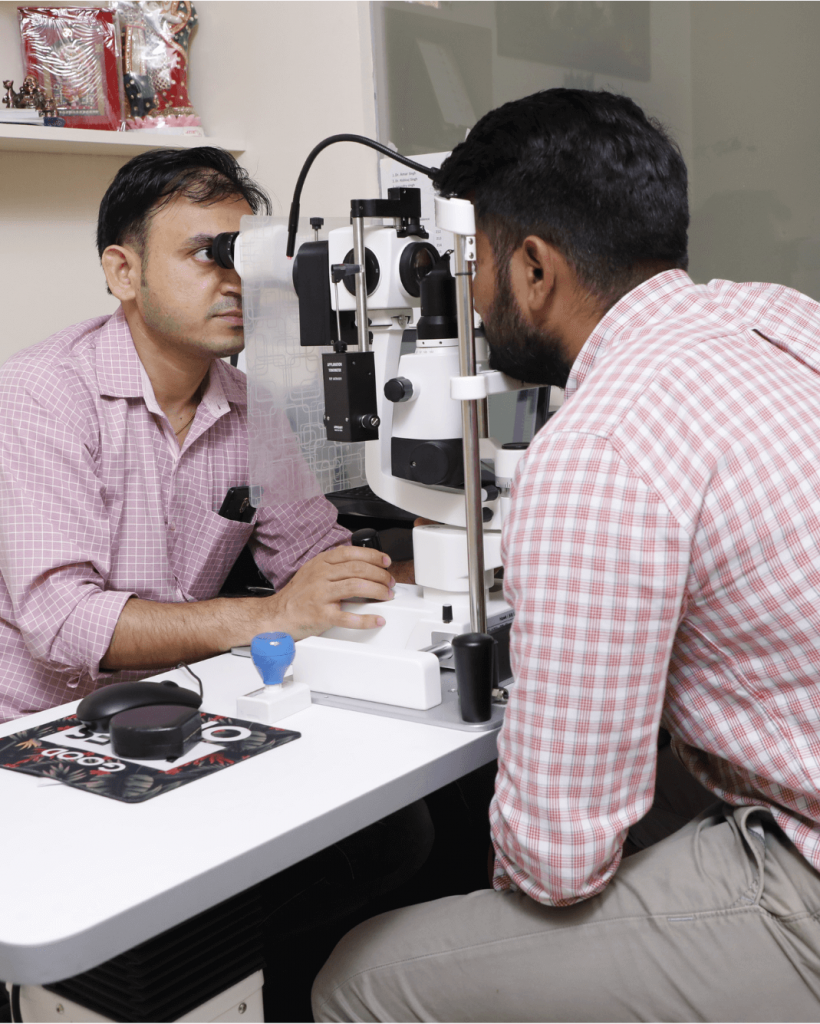Glaucoma
- Home
- Glaucoma
What is Glaucoma ?
Glaucoma is a group of eye conditions that can damage the optic nerve, which is responsible for transmitting visual information from the eye to the brain. This damage is often caused by increased pressure within the eye, known as intraocular pressure (IOP). However, it’s important to note that not all forms of glaucoma are associated with high eye pressure. Some forms, like normal-tension or low-tension glaucoma, can occur with normal or even lower-than-normal IOP.
The term “Kala Motia” is sometimes used in certain regions to refer to glaucoma, but it’s important to understand that glaucoma and cataracts are distinct eye conditions. Cataracts involve clouding of the eye’s lens, as discussed earlier, while glaucoma involves damage to the optic nerve, often associated with elevated eye pressure.
Glaucoma is indeed often referred to as the “silent thief of vision” because in many cases, it progresses without causing noticeable symptoms in its early stages. People might not realize they have glaucoma until their vision has been significantly affected. As the disease advances, it can lead to peripheral vision loss, and if left untreated, it can eventually result in central vision loss and blindness.
Regular eye exams are crucial for detecting and managing glaucoma, especially since early detection and treatment can help slow down or prevent further vision loss. Eye care professionals can measure intraocular pressure, assess the optic nerve, and conduct visual field tests to diagnose glaucoma. Treatment options typically include eye drops to lower eye pressure, laser therapy, and in some cases, surgery to improve fluid drainage from the eye.
It’s worth noting that while increased eye pressure is a major risk factor for glaucoma, not all cases are pressure-related. Some individuals can develop glaucoma with normal or even low eye pressure due to other factors such as poor blood flow to the optic nerve.
As with any eye condition, it’s important to consult with a qualified eye care professional for accurate diagnosis and appropriate management of glaucoma.
Symptoms of Glaucoma
Blurred Vision
Among the most frequent ones are refractive errors, which can lead to long- or short-sightedness. Other feasible reasons consist of infections, migraine, and cataracts. Most reasons of blurry imaginative and prescient are no longer serious.
Severe Eye or Forehead Pain
Sinus headaches are caused by sinusitis, or sinus inflammation. It is frequently caused by an infection or an allergic reaction. A dull, throbbing discomfort around the eyes, cheekbones, and forehead is one of the symptoms. Movement or straining can aggravate the pain,
02
Peripheral Vision Loss
Glaucoma injury to the optic nerve is the most prevalent cause of tunnel vision and peripheral vision loss. Eye strokes are another possible reason. Detachment of the retina.
03
Halos Around Lights
Sometimes it is a response to vibrant lights, particularly if you put on glasses or contact lenses to right nearsightedness, farsightedness or astigmatism. However, seeing these vibrant rings should be a facet impact of a serious eye ailment or different issue.
Redness of the Eyes
Red eyes typically are brought about via allergy, eye fatigue, over-wearing contact lenses or frequent eye infections such as red eye (conjunctivitis). However, redness of the eye once in a while can sign a extra serious eye circumstance or disease, such as uveitis or glaucoma.
05
Blind Spots in Field of Vision
If you get a blind spot in your vision, you would possibly have a serious problem called Scotoma. It is a blind spot or partial loss of imaginative and prescient in what is in any other case a flawlessly ordinary visible field
06
Treatment Options
Glaucoma valve is one of the latest glaucoma treatment techniques which helps in lowering intra ocular pressure and maintains a proper aqueous outflow. This technique is one of the preferred management option in cases struggling with glaucoma even after maximum medications and in complicated glaucoma cases.
FAQ
General Question
You can go through our blogs and website to get your questions answered.
If you are over 40 years old, have a family history of glaucoma or are of Asian/African or Hispanic heritage, you have a higher chance of developing glaucoma. Other risk factors include:
- Hypertension
- High myopia or hyperopia
- Experienced a previous eye injury/surgery
- Diabetes or other health concerns
Glaucoma is inherited, and having a family history of the condition has increased chances of developing glaucoma. If you have a positive family history of glaucoma, you should be conscious of the symptoms and see the ophthalmologist timely for scheduled tests. It offers you an early diagnosis of glaucoma. This helps us in proper management of glaucoma and prevention of further visual field loss.
Regular follow-ups and compliance with medications suggested by your glaucoma experts and scheduled investigations help you keep your glaucoma well controlled. Maintaining a healthy lifestyle, reducing alcohol and caffeine consumption and nutritious diet are also beneficial.
Glaucoma causes irreversible visual field losses. The treatment is focused on preserving vision as uncontrolled glaucoma may lead to total lost of vision. If diagnosed timely and managed well, vision loss can be prevented.


